Nvidia and AMD make the best graphics cards you can buy, but choosing between them isn’t easy. Unlike previous generations, AMD and Nvidia trade blows point-for-point in 2024, and picking a brand to go with isn’t as easy as counting the dollars in your wallet.
I’ve reviewed every graphics card AMD and Nvidia have released this generation, comparing not only raw performance, but also features like DLSS and FSR, ray tracing performance, and how VRAM works in modern games. After dozens of graphics card reviews, here’s how AMD and Nvidia stack up against each other in 2024.
Nvidia vs. AMD in 2024

Before getting into the details, let’s set the stage for Nvidia and AMD in 2024. Both have mature generations of graphics cards, and I don’t expect we’ll see any more entries. We’re looking forward to the end of this year and early next year for Nvidia and AMD to release their next generation of graphics cards.
Nvidia has its Ada Lovelace GPUs, more commonly referred to as RTX 40-series graphics cards. There are 10 cards in total, though only eight are technically part of Nvidia’s lineup. It sounds confusing, but the list below should clear things up.
- RTX 4090
- RTX 4080 Super
- RTX 4080 (discontinued)
- RTX 4070 Ti Super
- RTX 4070 Ti (discontinued)
- RTX 4070
- RTX 4060 Ti 16GB
- RTX 4060 Ti 8GB
- RTX 4060
The two missing GPUs are the RTX 4070 Ti and RTX 4080, both of which have been replaced by a Super refresh. The RTX 4070, the only other GPU with a Super refresh, still lives alongside the refreshed model. Although the RTX 4080 and RTX 4070 Ti are technically discontinued, you can still find some models in stock at the time of writing.
Outside of the Super shifting, the only other oddity in Nvidia’s lineup is the RTX 4060 Ti. Nvidia sells two versions of this GPU, one with 8GB and the other with 16GB. They’re the exact same graphics card, just with a difference in memory capacity.
AMD has a smaller lineup at seven GPUs, and there aren’t any Super refreshes to contend with. Here’s how AMD’s RDNA 3 range looks at a glance:
- RX 7900 XTX
- RX 7900 XT
- RX 7900 GRE
- RX 7800 XT
- RX 7700 XT
- RX 7600 XT
- RX 7600
In both cases, we ordered the graphics cards from most to least powerful — the RTX 4070 Ti is more powerful than the RTX 4070, for example. This can help you get your bearings when looking at Nvidia or AMD’s lineup, but the comparison between the two brands is a little murky.
Below, you can see a table showing how the options from AMD and Nvidia compare roughly. We’ll get into performance and pricing later, but this shows the rough equivalents from both brands.
| Nvidia | AMD |
| RTX 4090 | — |
| RTX 4080 Super/RTX 4080 | RX 7900 XTX |
| RTX 4070 Ti Super | RX 7900 XT |
| RTX 4070 Ti | — |
| RTX 4070 Super | RX 7900 GRE |
| RTX 4070 | RX 7800 XT |
| — | RX 7700 XT |
| RTX 4060 Ti 16GB/8GB | — |
| — | RX 7600 XT |
| RTX 4060 | RX 7600 |
There are a couple of odd gaps in the lineup, so you won’t always have an alternative to one GPU if you’re locked on a particular brand. Again, we ordered the cards here by overall power, and the gaps represent that. For instance, the RTX 4060 Ti is more powerful than the RX 7600 XT, and the RX 7700 XT is more powerful than that.
Pricing and availability
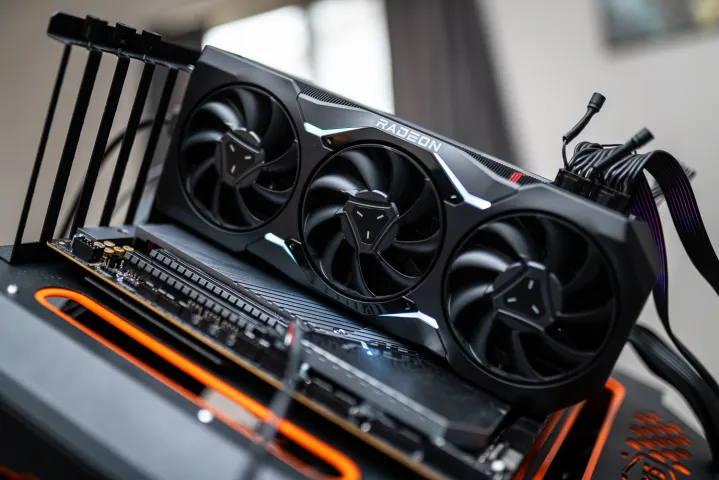
There isn’t much sense in comparing the list prices of AMD and Nvidia’s current GPUs. Prices have shifted as the generation has gone on, putting some GPUs in more direct competition with each other. Here’s a breakdown of what you can expect to spend on a current-gen GPU at the time of publishing:
- RTX 4090 —
- RTX 4080 Super —
- RX 7900 XTX —
- RTX 4070 Ti Super —
- RX 7900 XT —
- RTX 4070 Super —
- RX 7900 GRE —
- RTX 4070 —
- RX 7800 XT —
- RTX 4060 Ti 16GB —
- RX 7700 XT —
- RTX 4060 Ti 8GB —
- RX 7600 XT —
- RTX 4060 —
- RX 7600 —
There are a couple of overall trends. If you compare this list of prices with the stack of GPUs above, you’ll see that AMD GPUs are generally cheaper. Not only is the RX 7600 the cheapest GPU available out of the current-gen lineups, but cards like the RX 7800 XT come in slightly cheaper than the direct competition in the form of the RTX 4070.
All but one of these GPUs are readily available at online retailers, either for list price or below list price. The RTX 4090 is the exception. The AI boom caused it to fly off the shelves, and even today, it’s hard to find one available for under $2,000. It’s not a great time to buy the RTX 4090, and it might never be.
Even without the RTX 4090 fiasco, AMD is clearly ahead on pricing. There’s a lot of segmentation in Nvidia’s lineup, particularly between $400 and $600. AMD has a much more concise lineup around this price, with clear steps in performance between each entry. At the high-end, Nvidia GPUs are still sitting at list price, mostly propped up by the Super refresh, while AMD’s options have slowly fallen in price.
Winner: AMD
Performance
I have reviews of all of Nvidia and AMD’s current-gen GPUs linked above. If you’re interested in a particular card, make sure to read our reviews for a full breakdown of benchmarks. Here, we’re going to hit some general notes of comparison for the three major resolutions, accounting for our full test suite.
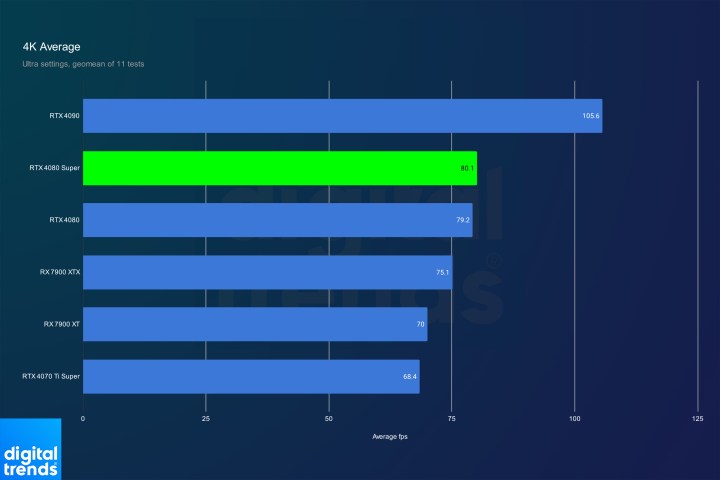
Starting with 4K, Nvidia clearly wins the higher end of performance. The RTX 4090 is way too powerful of a GPU to contend with, placing Nvidia far in the lead. Down the stack, the RTX 4080 Super wins over AMD’s direct competition, but below $1,000, AMD comes out ahead. That’s showcased by the RX 7900 XT, which is ahead of the RTX 4070 Ti Super despite being $100 cheaper.

That story continues at 1440p, mainly on the back of the RX 7900 GRE. It beats the RTX 4070 Super while running $50 cheaper, and it vastly outpaces the RTX 4070 at the same price. Similarly, the RX 7800 XT comes out slightly ahead of the RTX 4070 despite being around $50 cheaper.
These tests include our full suite, which has a handful of ray-tracing titles, too. We’ll take a closer look at ray tracing in the next section, but that’s an area where Nvidia normally holds a lead. Outside of ray tracing, the direct competition from AMD generally holds up better at the same price.
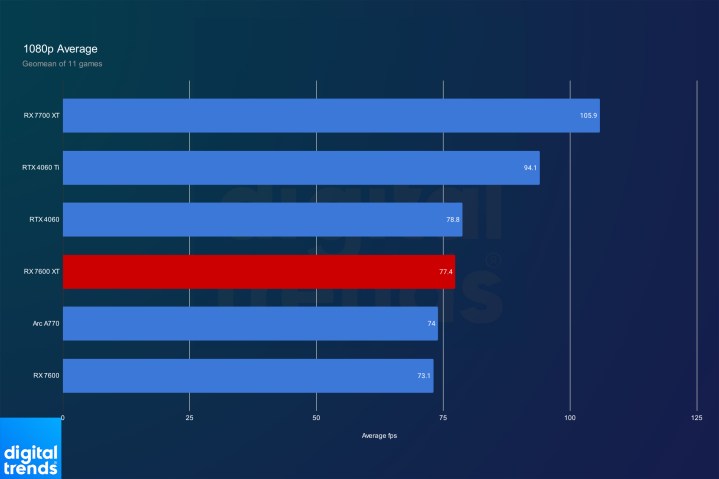
Things change at 1080p, which is surprising given the lukewarm reception of cards like the RTX 4060 from Nvidia. The RX 7700 XT is a great option compared to the RTX 4060 Ti, but down lower, the RX 7600 and especially the RX 7600 XT fail to impress. Nvidia offers a better balance with the RTX 4060 and RTX 4060 Ti for 1080p gamers right now.
If we look at overall performance, AMD delivers more performance for your dollar in the sweet spot between higher-end 1080p gaming and lower-end 4K gaming. Nvidia delivers better peak performance overall and a better value lower down the stack. However, there are many considerations outside of performance.
In the next two sections, we’ll discuss ray tracing and feature support, where the scales tip back in Nvidia’s favor. For this section, AMD wins for better overall performance.
Winner: AMD
Ray tracing
Nvidia has been the leader in ray tracing since the introduction of RTX GPUs in 2018, but AMD is much closer now than it used to be. A big reason why is that we’re seeing more games with less demanding ray tracing implementations, such as Resident Evil 4, where AMD’s GPUs run much better than they did in years past.
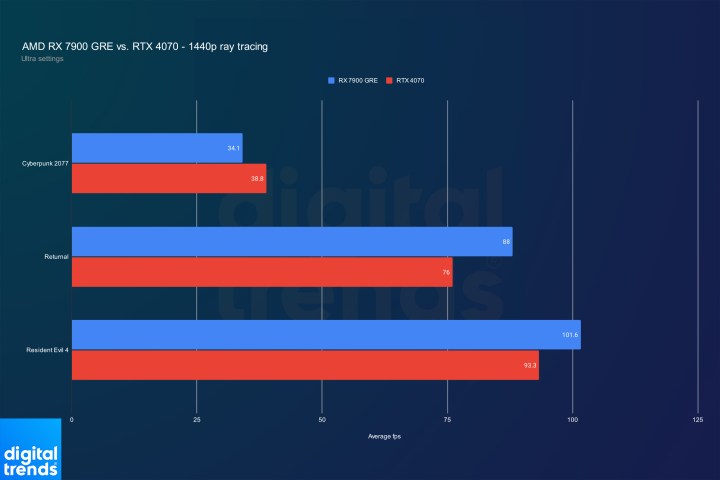
You can see that in action above. In less demanding games like Returnal and Resident Evil 4, the RX 7900 GRE beats the RTX 4070 with ray tracing turned on, despite the fact that the two GPUs come in at the same price.
There’s a lot more to this story, however, and Cyberpunk 2077 provides a hint as to why. In the most demanding ray tracing games, Nvidia leads. As you can see in the section above, the RX 7900 GRE is about 16% faster than the RTX 4070 overall, which is an average that includes these ray tracing results. Despite that massive lead, Nvidia still comes out ahead in Cyberpunk 2077.
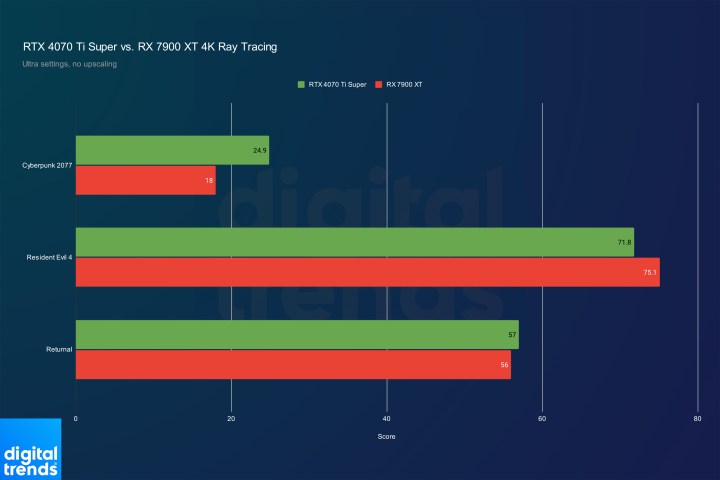
If you look at the comparison between the RTX 4070 Ti Super and RX 7900 XT, you can see how Nvidia still holds the lead in ray tracing. The cards trade blows with the less demanding titles, but Nvidia holds a massive lead in Cyberpunk 2077.
AMD is competitive in some ray tracing games, but Nvidia still wins this section. You want to see your ray tracing, and that generally comes at a big performance cost. Titles like Cyberpunk 2077, Alan Wake 2, and Portal with RTX look incredible due to the complex, taxing lighting tech, and Nvidia can handle the heat of those demanding scenarios far better.
Winner: Nvidia
DLSS and FSR

There’s a big trend toward features defining how good or bad a particular GPU is. We’ve seen AMD and Nvidia both heavily invest in software beyond the silicon over the past few years. For AMD, it’s FidelityFX Super Resolution (FSR), and for Nvidia, it’s Deep Learning Super Sampling (DLSS). And there are a ton of differences between them.
Starting with AMD, FSR compromises two components. The first part is upscaling, which works with any GPU and offers a performance boost by rendering your game at a lower resolution. A small set of games also support FSR 3, which adds frame generation into the mix. This compares two frames and generates one in between to boost your frame rate.
The big boon for FSR is that it’s brand agnostic; it works with Nvidia, AMD, and Intel GPUs. The drawback is that it doesn’t always look the best. You can see that in Horizon Forbidden West above. Compared to DLSS, FSR is much softer, particularly with Aloy’s hair and the vegetation surrounding the character.
Another drawback, at least right now, is FSR 3 frame generation. It looks great, but only a small number of titles support the feature. Games like Cyberpunk 2077, Warhammer 40K: Darktide, and Ratchet and Clank Rift Apart, which have promised frame generation, have yet to receive an update for FSR 3.
On Nvidia’s end, you have DLSS. It includes three core components: Super Resolution, which is upscaling; Ray Reconstruction, which improves the quality of ray-traced effects; and Frame Generation, which compares two frames to generate one in between. The big difference between FSR and DLSS is that DLSS uses AI for all of its components and requires an RTX GPU to run the AI model on dedicated accelerators.
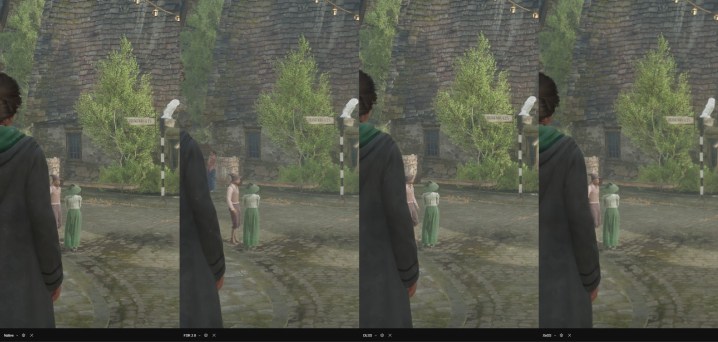
You can see in Hogwarts Legacy how AI makes a difference. On the shingles, DLSS is able to maintain much more detail than FSR. In addition, DLSS is much more stable. Both FSR and DLSS are subject to ghosting and flickering artifacts, but DLSS generally handles fine details better than FSR does.
DLSS Super Resolution and Ray Reconstruction work on all RTX GPUs, but Frame Generation only works on new RTX 40-series GPUs. It looks slightly better than FSR 3, but the two features are close. The big boost for Nvidia is that DLSS 3 is in a ton of games, such as Alan Wake 2, Cyberpunk 2077, and Remnant 2.
Since the introduction of DLSS, Nvidia has been one step ahead of AMD in the features department, and that remains true today. DLSS is one of the main reasons to buy an Nvidia GPU, and it’s a big reason why games like Alan Wake 2 and Cyberpunk 2077 are even possible with their demanding path-tracing modes.
Winner: Nvidia
Software and drivers
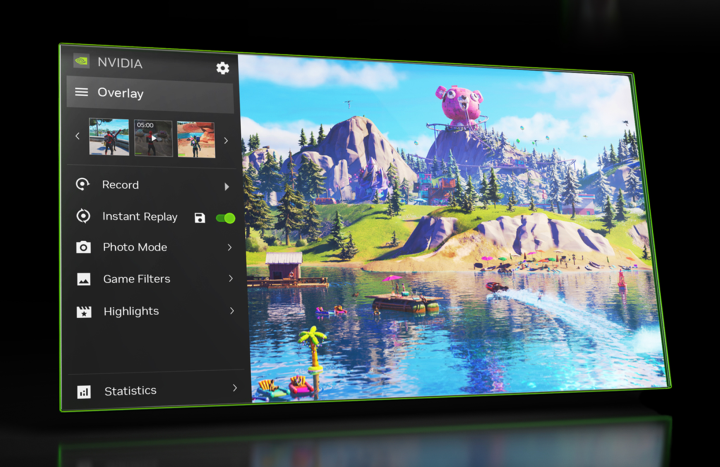
There isn’t much of a comparison between AMD and Nvidia when it comes to driver support. We’ve seen issues with both when it comes to driver releases in the past, and both are quick to solve those issues when they come up. AMD and Nvidia also frequently release drivers alongside new game releases. Single out a single game or single-driver release, and you’ll find a winner. Overall, AMD and Nvidia are evenly matched in driver quality and support.
Software is a different matter. Nvidia used to be in a distant second place to AMD, but that all changed with the Nvidia App. Now, you have a unified app for Nvidia that encompasses not only drivers, recommended settings, and gameplay recording, but also other apps like Nvidia Broadcast and ICAT.
You get your standard suite of features, including a screenshot function, recording through Nvidia Shadowplay, and instant replay. Nvidia has a few unique features through Freestyle, though. With an RTX GPU, you can use RTX Dynamic Vibrance and RTX HDR, both of which use AI to enhance the look of your games.
Unlike the previous version of the Nvidia App — called GeForce Experience — you don’t need to create an account with Nvidia to access any of these features. That alone does a ton to balance the scales between Nvidia and AMD with software.
AMD has Radeon Software, which comes with a similarly robust list of features. It has almost too many to list. Like GeForce Experience, you can access instant replay, screenshot and video capture, performance monitoring, and graphical settings for supported games. You can also stream with Radeon Software and apply an overclock to your GPU.
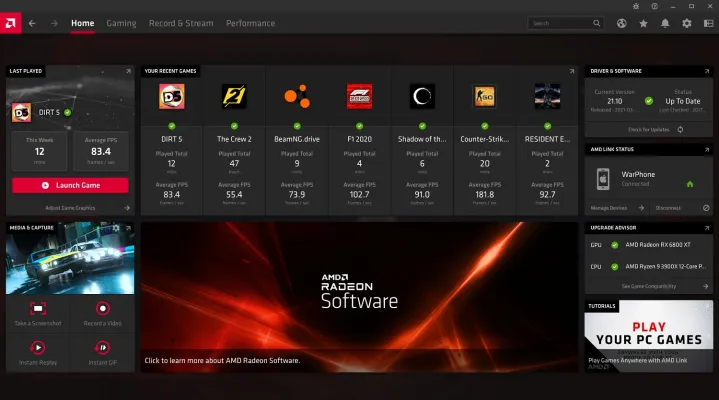
Radeon Software has a few extra goodies, though. Integer Scaling, for example, upscales retro games to work on modern displays, and AMD Link allows you or your friends to connect to your PC remotely on almost any device. All of AMD’s gaming features — FreeSync, Radeon Chill, and Radeon Anti-Lag, to name a few — are accessible through Radeon Software as well.
AMD had a massive lead with Radeon Software in years past, but the new Nvidia apps bring Team Green up to par. Now, it’s hard to go wrong with either.
Winner: Tie
Mobile GPUs
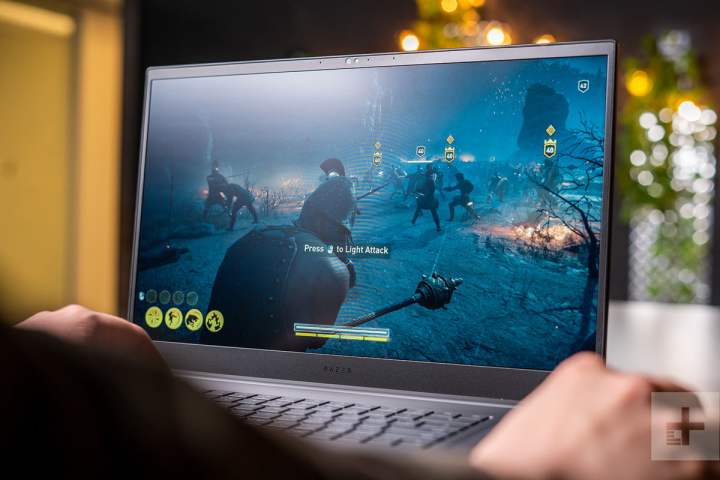
Along with desktop graphics cards, Nvidia and AMD have mobile GPUs. But you’ll find a lot more laptops with Nvidia graphics cards. Similar to Intel vs. AMD, Nvidia has a much larger stake in the mobile market, and you’ll generally find laptops with an Nvidia graphics card and Intel processor.
It’s difficult to draw any firm conclusions about how AMD and Nvidia mobile GPUs perform compared to each other. For example, the RX 6800M inside the Asus ROG Strix G15 outperforms the RTX 3080 inside the MSI GS66 Stealth. The MSI laptop doesn’t feature a fully powered RTX 3080, though, and it doesn’t have as robust a cooling solution. So, is AMD better for mobile graphics cards? It’s a little more complicated than raw performance.
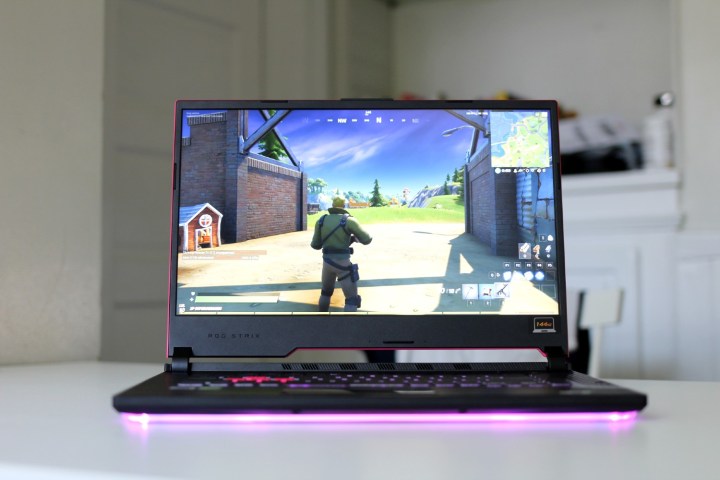
Mobile graphics cards don’t match their desktop counterparts, and laptop designers are free to choose how much power the cards get. The RTX 3080 inside the MSI GS66 Stealth, for example, tops out at 95W. The RTX 3080 inside the Razer Blade 15 can draw up to 105W of power, and it unsurprisingly performs better. Add on top of that different cooling solutions, and the comparison isn’t so straightforward.
When it comes to mobile GPUs, individual laptop reviews are a must. There are absolutely differences between graphics cards — the RX 6800M will perform better than the RX 6700M, and so on. But when it comes to two comparable graphics cards, the laptop design plays a much more significant role in performance than if you went with an AMD or Nvidia GPU.
Keep in mind DLSS and ray tracing, though. Nvidia mobile GPUs still have access to these features, and our conclusions on the desktop cards apply here.
Winner: Nvidia
Performance parity, feature leader (Nvidia wins)

AMD has tried to reach performance parity with Nvidia for years. And RX 7000 graphics cards hit that mark, sometimes even exceeding it. That puts the focus on pricing and features. For pricing, AMD graphics cards are selling for less than their Nvidia counterparts. Factor in ray tracing and DLSS, though, and that extra price is justified.
That doesn’t mean AMD is a bad option. In 2024, AMD is a better option than it has been in years. That’s particularly true if you’re looking to get the most overall performance for your dollar, and you don’t care much about extra features. Those features are an important factor for a lot of games this year, however, and because of that, Nvidia is our winner.
Editors' Recommendations
- Meet Blackwell, Nvidia’s next-generation GPU architecture
- GPU prices and availability (Q1 2024): How much are GPUs today?
- I tested AMD’s RX 7600 XT against the RTX 4060 — and I was shocked by the results
- AMD might have a new graphics card next month, too
- Graphics terms every PC gamer should know





